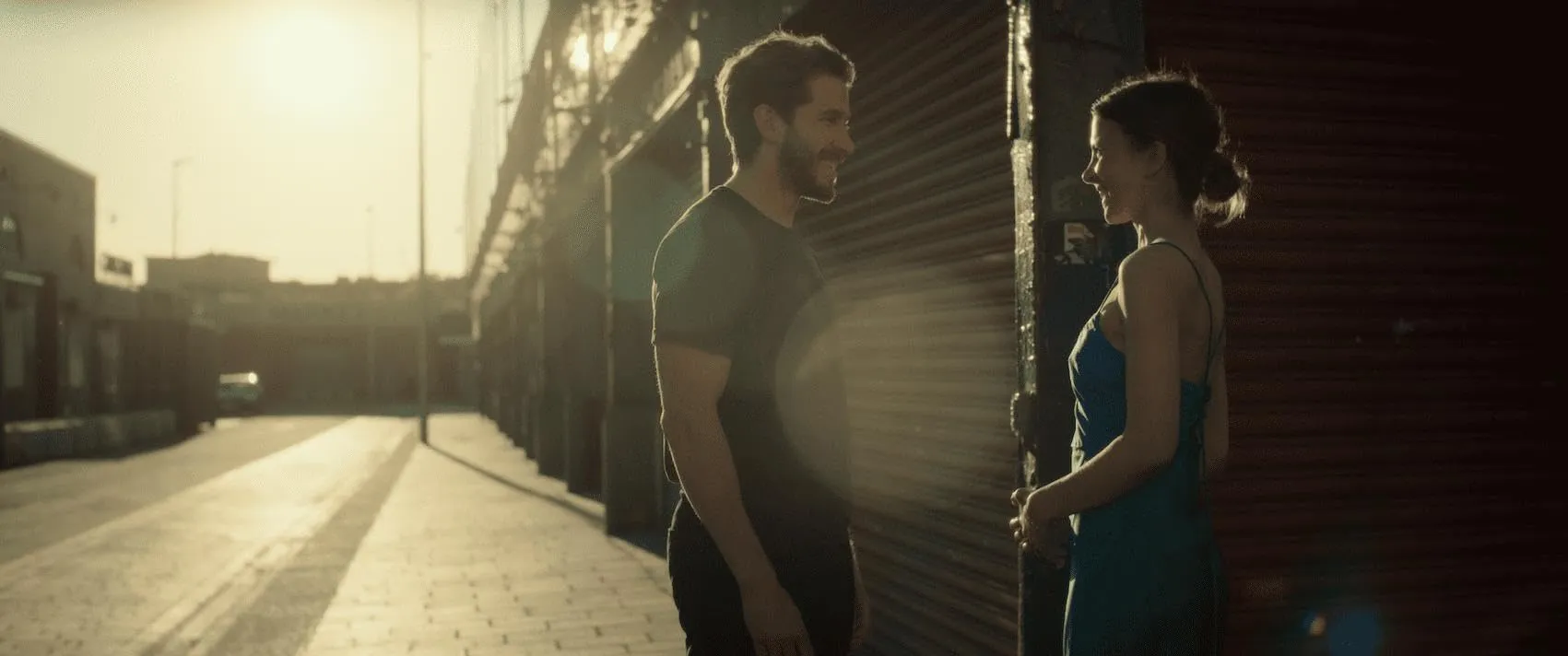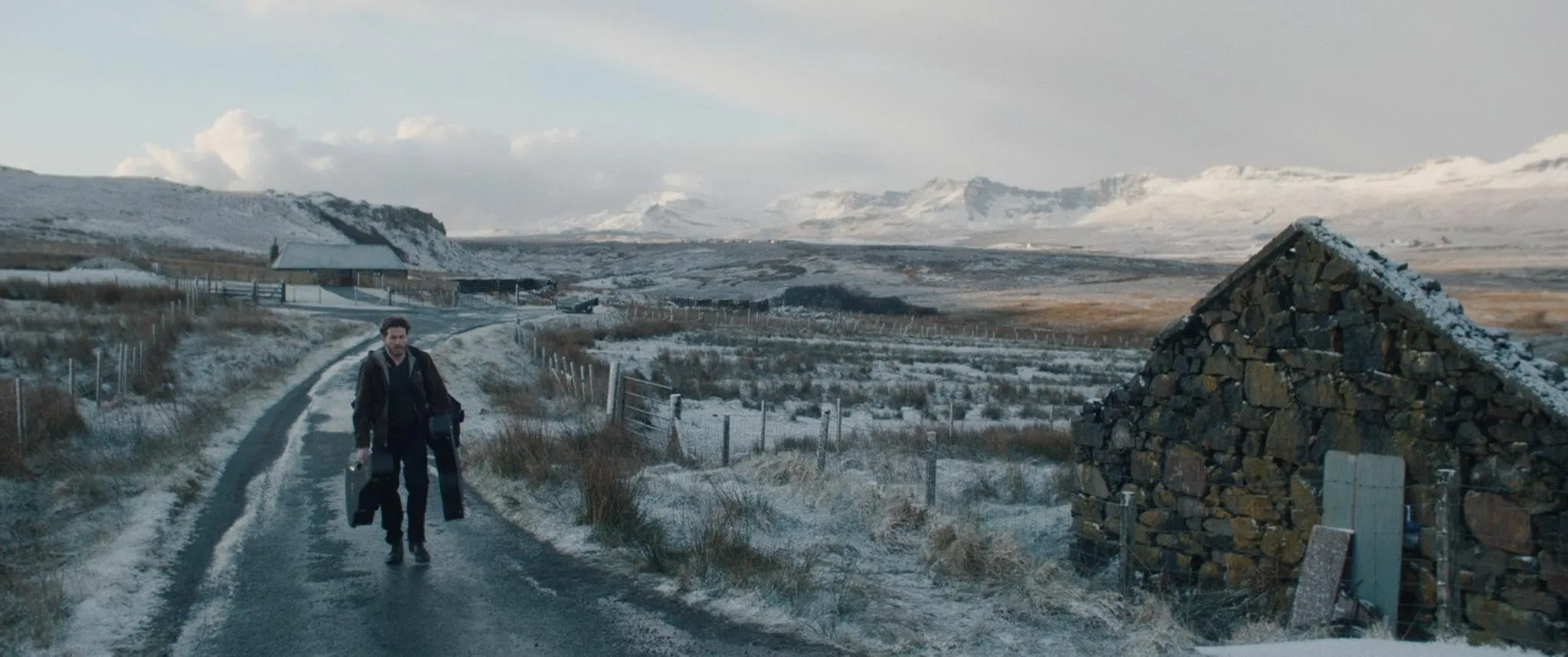Aylin Tezel’s directorial debut, “Falling Into Place,” arrives with the writer-director also taking the lead role and scripting duties—a trifecta of involvement that often signals a deeply personal project. The film introduces us to Kira and Ian, two souls adrift in their early thirties, each tethered to their own distinct burdens and pasts.
Their paths cross, ignite briefly with a potent connection, and then diverge, leaving the narrative to explore the subtle, often unacknowledged ways such fleeting encounters can resonate through the architecture of a life. The story unfolds between the stark, evocative landscapes of the Scottish Isle of Skye and the sprawling, often anonymous backdrop of London, settings that become characters in their own right.
The initial encounter on Skye is constructed with a familiar, yet effective, romantic shorthand. Kira, a German set-designer based in London, is escaping the fresh wreckage of a long-term relationship, seeking solace or perhaps just distraction on an impulsive trip. Ian, a Londoner himself, is back in his starkly beautiful, yet emotionally fraught, hometown to deal with unresolved family matters.
Their meeting in a pub has the charged air of inevitability that romantic dramas often lean on. What follows is a condensed 24-hour universe for two: nights filled with candid talk, mornings with the giddy energy of new discovery, and an unspoken understanding that seems to bypass the usual guarded introductions. They dance, they share, they connect with an intensity that the brevity of their time together amplifies. Then, almost as quickly as it began, it’s over.
They part without the modern ritual of exchanged numbers, a deliberate narrative choice that underscores the ephemeral nature of their bond while simultaneously planting the seed of its significance. Even in these early scenes, the film sketches the foundations of their individual vulnerabilities—Kira’s introspective melancholy, Ian’s charming yet somewhat avoidant demeanor—hinting at the internal landscapes they each navigate.
Navigating the Interior Landscapes of Modern Love
“Falling Into Place” dedicates substantial narrative space to investigating the intricate dynamics of seeking connection when one is already well into the third decade of life. This is not a story of youthful, uncomplicated first love.
Instead, it delves into the more complex terrain of romance when lives are already in progress, complete with the entanglements of previous relationships and the weight of personal histories. The film approaches the emotional struggles of Kira and Ian with a degree of sensitivity.
Their internal battles, be it Kira’s grappling with past heartbreak or Ian’s unease with familial and personal expectations, are not presented as dramatic plot twists but as persistent undercurrents that subtly shape their choices and their capacity for intimacy. These portrayals aim for a clear-eyed look at how individual well-being, or the lack thereof, informs how one moves through the world and interacts with potential partners.
The script appears particularly interested in the role of timing—or perhaps, mistiming—in romantic trajectories. The Skye encounter feels like a moment out of sync with their everyday realities, a bubble of possibility that bursts when confronted with the pressures of their London lives.
The film seems to posit that the influence of such a profound, albeit short-lived, meeting can be unexpectedly formative, nudging characters toward introspection or even recalibrating their perspectives on what they seek.
A palpable sense of longing threads through their separate narratives post-Skye: a longing for that initial, uncomplicated connection, certainly, but also a deeper yearning for stability, for self-acceptance, or perhaps simply for a life that feels more authentically their own. The narrative doesn’t shy away from depicting their fumbles, making their journeys feel relatable, if occasionally frustrating to witness.
Crafting Connection: Direction, Performance, and Place
Aylin Tezel’s direction benefits from her perspective in front of the camera. There’s an observable focus on capturing the nuances of character interaction, often prioritizing unspoken emotional exchanges over overt exposition. The visual storytelling frequently relies on the actors’ expressions, particularly their eyes, to convey internal states.
Close-ups are used judiciously to draw the audience into intimate moments, and there’s a keen awareness of how characters occupy and interact within a shared space, possibly a nod to Tezel’s background in dance and acting. This often allows the emotional core of a scene to resonate without being verbally underlined, a welcome restraint.
As Kira, Tezel delivers a performance that feels heartfelt and grounded in the character’s introspective nature. Chris Fulton’s Ian is a more complex proposition; he navigates Ian’s initial charm and subsequent, more difficult, emotional states with a dexterity that makes the character feel understandable even when his actions are questionable.
The chemistry between the two leads is consistently highlighted as a significant strength. Their interactions, particularly on Skye, possess a playful, magnetic quality that sells the initial, rapid bond. This connection is pivotal, as the narrative relies heavily on its lingering impact. The film effectively uses its two primary locations as more than mere backdrops.
The rugged, expansive beauty of Skye offers a sense of freedom and elemental intensity, mirroring the initial rush of Kira and Ian’s connection. In contrast, London is depicted as a bustling, sometimes isolating, urban landscape.
Their lives there are often shown in dimly lit interiors or amidst the hurry of the city, reflecting their individual struggles and the precariousness of their artistic pursuits. The soundtrack, with its reported blend of soulful songs and evocative piano, likely aims to further enhance this atmospheric storytelling, underscoring the emotional contours of their journey.
The Architecture of an Encounter and Its Aftermath
The narrative architecture of “Falling Into Place” is quite distinct, cleaved almost neatly into two halves: the catalytic meeting on Skye, and the subsequent, more diffuse exploration of its ripple effects in their London lives. This structural choice allows for a focused examination of how that brief, intense period continues to inform Kira and Ian’s separate paths.
The pacing appears to be largely deliberate, a melancholic slow-burn that attempts to give emotional developments room to breathe. This approach, while fostering a reflective mood, occasionally risks meandering, particularly during the second act as the characters navigate their individual existences apart. The audience is made aware that these two are destined, or at least narratively nudged, towards a reunion, and the film spends considerable time charting the course of their lives until that point.
How the story handles their individual growth—or lack thereof—during their separation is key to the film’s ambitions. Kira’s art and Ian’s music become outward expressions of their internal processing of the Skye encounter. The eventual reunion, a staple of the genre, carries the weight of this build-up.
The effectiveness of such a structure often hinges on whether the time spent apart enriches the eventual convergence, or makes the waiting feel somewhat drawn out.
“Falling Into Place” seems to want the audience to consider the unpredictable manner in which human connections, however brief, can imprint upon us, shaping our understanding of ourselves and what we seek from life and love. It offers a narrative that is less about the grand, sweeping gestures of romance and more about the quieter, internal shifts that occur as individuals try to find their footing.
Falling Into Place premiered at the Filmfest Hamburg on October 3, 2023, and was released in German cinemas on December 7, 2023. It has since been showcased at various international film festivals, including the Tallinn Black Nights Film Festival, where it won the FIPRESCI Award, and the Glasgow Film Festival in March 2024. The film is scheduled for theatrical release in Ireland on June 6, 2025, and a television broadcast in France on June 13, 2025 .
Full Credits
Director: Aylin Tezel
Writer: Aylin Tezel
Producers and Executive Producers: Yvonne Wellie, Jakob D. Weydemann, Jonas Weydemann, Milena Klemke, John McKay, Jennifer Armitage
Cast: Aylin Tezel, Chris Fulton, Rory Fleck-Byrne, Alexandra Dowling, Samuel Anderson, Juliet Cowan, Olwen Fouéré, Michael Carter, Anna Russell-Martin, Cian Barry
Director of Photography (Cinematographer): Julian Krubasik
Editor: David J. Achilles
Composers: Ben Lukas Boysen, Jon Hopkins
The Review
Falling Into Place
"Falling Into Place" is a heartfelt directorial debut from Aylin Tezel, anchored by strong, intimate performances and a palpable chemistry between its leads. While its narrative of a fleeting, impactful connection occasionally meanders in its exploration of thirty-something angst and emotional baggage, the film’s earnest engagement with the complexities of modern love and self-discovery offers a poignant, if familiar, cinematic experience. It succeeds more in its quiet, observational moments than in its broader structural ambitions.
PROS
- Compelling chemistry and nuanced performances from Aylin Tezel and Chris Fulton.
- Thoughtful exploration of connection, longing, and emotional realities in one's thirties.
- Effective use of contrasting atmospheric settings (Skye and London).
- Intimate directorial approach that favors subtle emotional expression.
CONS
- Pacing can be slow, particularly in the film's second half.
- The narrative structure, while intentional, may feel drawn out to some viewers.
- Supporting characters are less developed compared to the leads.
- Some romantic drama conventions feel quite familiar.


















































